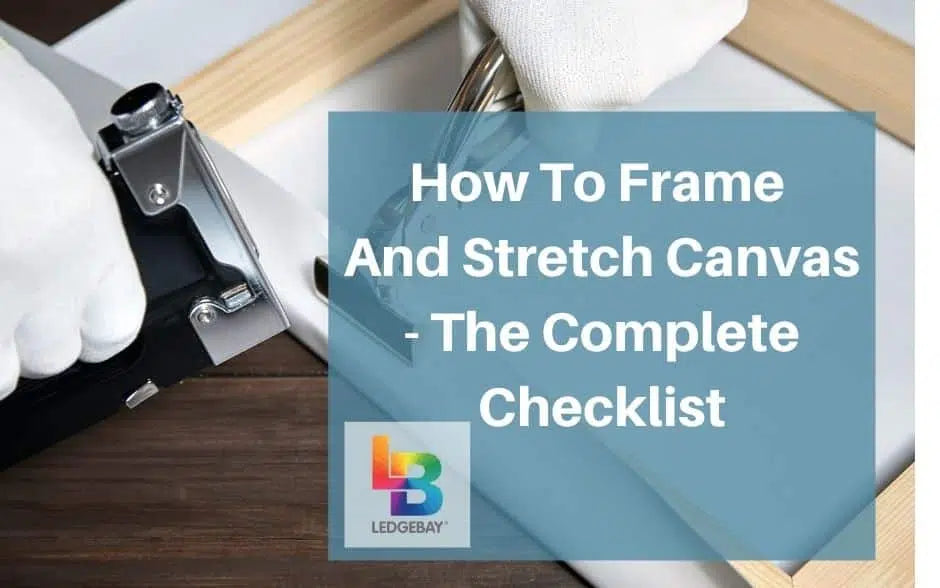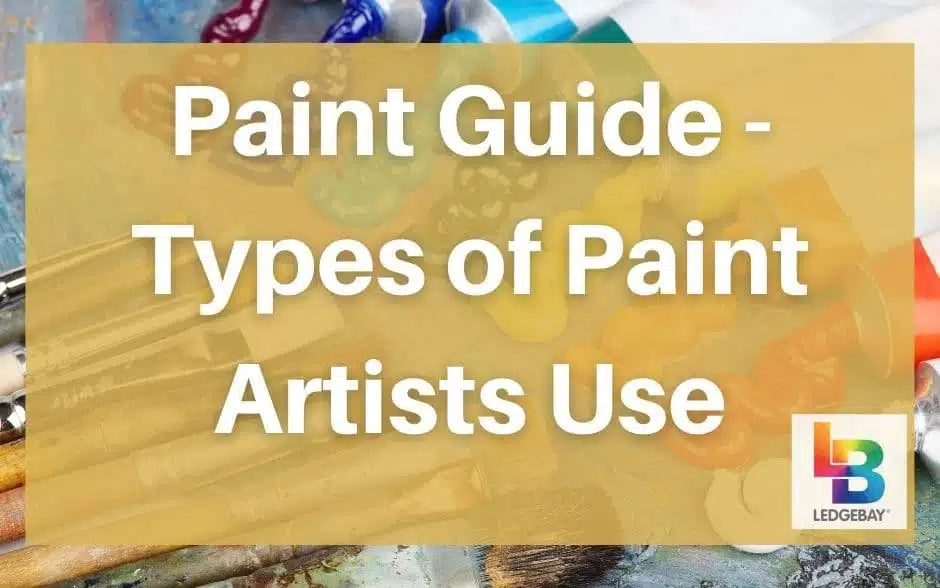One of the most valuable tips to avoid post-coloring issues whilepainting paint by number kits is getting the canvas framed beforehand.
However, some people might quickly start framing them without knowing how tostretch canvas first, which causes wrinkles and distortions that can easily ruin thepainting .
Whether you’re a pro painter or abeginner paint by number kit enthusiast, learning how to stretch and frame your canvases will save you a lot of money and time. This article will explainhow to put canvas on a frame and do it right.
Luckily, the process is fairly easy if you have a simplestep by step painting guide to get the job done, and that’s where this complete checklist will come in handy. So without further ado, let’s dive in!
Beforestretching the canvas onto the frame , make sure its dry and clean. Next, attach your scrap wood together with the wood glue - this will form the frame.
When it comes to stretching the canvas onto the frame, use tacks or staples at regular intervals along all edges of the canvas. A good tip is to place staples four inches apart in a diagonal pattern for maximum durability.
When you're done stretching, give your masterpiece a final once over and admire your handiwork!
Before hopping into the juicy stuff, make sure that you prepare all the needed items for the job.
Fortunately, when it comes topainting by number kits, you’ll have almost all the needed tools ready. Frames that come with the canvases are usually designed to be connected using grooves without needing nails in the process.
However, there might be some items that you might still need to properly stretch a canvas, including:
Since it’s where the canvas aligns, the first thing you should start with is getting the frame assembled.
Canvas stretch bars come in various sizes and groove shapes that perfectly slip into one another. Here’s how to get them ready!
Start by getting all the stretch bars laid out on a flat surface. This can help you figure out if there are any bends or broken parts that you should be concerned about.
Usually, these wooden stretch bars are durable enough so you most likely won’t have any problems in that step.
If you happen to find one, contact the seller for replacement, as these bars might cause distortions to thepainting .
This can be done using any old andclean toothbrush or tiny brush . With smooth edges, you’ll easily slide these wooden bars into one another without a problem.
Connect a third stretch bar to the structure you already created. Ideally, it should be another small bar connected to the other edge of the long one, so you have a strong base.
Lastly, connect the final piece of the stretch bar into the structure, creating a rectangular or square shape.
Sometimes, the stretch bar frame might not be fully tightened, as it’s hard to get that 90-degree angle without tapping or wiggling with your hand. The easiest way to do it is by using a mallet.
Avoid using a hammer because it can easily dent the wooden frame. You might as well use a piece of a scrap between the wood and the mallet to further protect it.
With the four pieces attached, bring a wooden or rubber mallet, and start gently tapping the edges till it fully sinks inside.
This is perfectly fine since you can easily stretch the canvas to flatten them. With the stretch bars frame assembled, it’s time to put it aside andget your canvas ready before framing.
Lay the canvas flat on a smooth surface and make sure you put anything away for the time being to avoid messy and irreversible pain accidents.
In the majority of situations, you won’t find anything more than some wrinkles and creases due to storage and the weather, which you’re going to deal with shortly.
If thecanvas isn’t treated with gesso, some experts suggest that you spray it with a small amount of water to prompt shrinkage, as this can help you find all the wrinkles on the canvas before ironing it.
If you’re stretching apaint by number kit , avoid spraying any water on the canvas before ironing it, as this can make the lines and numbers printed fade away.
Instead, you can lay the canvas face down and put a damp piece of cloth on the back on top of the canvas while ironing.
This alternative method gives the same effect of wetting the canvas without worrying about the printed items.
First, make sure that you iron the canvas facing down and never up, especially forpaint by number kits .
By doing that, you’ll avoid any smudges or damages to the face that has the print lines on.
After that, lay theframe on top of the canvas where the flat side of the stretch bar frame is towards the canvas and the beveled edge is facing you.
This helps in creating the round edge needed to lower the friction and damage of the canvas edges.
Make sure you do that under bright light, so you can adjust it correctly with the borders of the drawing.
You can do this by using thumbtacks that usually come along with thepainting by number kit . However, if you don’t like it, it’s totally fine to use a staple gun and replace it with 2 to 3 staples.
The thumbtacks are preferred for beginners because you can insert them halfway only for easy removal in case of readjustments.
With an ultra-fine mister, you can prompt shrinkage needed for an extra taught canvas. Avoid using too much water as one spray from the mister on the backside is more than enough toprevent smudges .
By following this guide, you’ll make sure that yourpainting stays tightly stretched over the frame for excellent painting results! Now, you cantry your hand at painting Van Gogh's Starry Night or theThe Great Wave Off Kanagawa .
If this is too much work for you, check out the Ledgebay Pre-Framed Paint By Number Kits -->CLICK HERE
However, some people might quickly start framing them without knowing how tostretch canvas first, which causes wrinkles and distortions that can easily ruin thepainting .
Whether you’re a pro painter or abeginner paint by number kit enthusiast, learning how to stretch and frame your canvases will save you a lot of money and time. This article will explainhow to put canvas on a frame and do it right.
Luckily, the process is fairly easy if you have a simplestep by step painting guide to get the job done, and that’s where this complete checklist will come in handy. So without further ado, let’s dive in!
Creating Your Own Frame
Creating a beautiful stretched canvas painting doesn't have to be an expensive affair. Just grab some scrap wood, wood glue, offset clips, stretching canvas - and you can create your own frame for your masterpiece.Beforestretching the canvas onto the frame , make sure its dry and clean. Next, attach your scrap wood together with the wood glue - this will form the frame.
When it comes to stretching the canvas onto the frame, use tacks or staples at regular intervals along all edges of the canvas. A good tip is to place staples four inches apart in a diagonal pattern for maximum durability.
When you're done stretching, give your masterpiece a final once over and admire your handiwork!
Essential Items That You’ll Need for This Guide
[amazon box="B00MWVAUUA"]Before hopping into the juicy stuff, make sure that you prepare all the needed items for the job.
Fortunately, when it comes topainting by number kits, you’ll have almost all the needed tools ready. Frames that come with the canvases are usually designed to be connected using grooves without needing nails in the process.
However, there might be some items that you might still need to properly stretch a canvas, including:
- An old toothbrush or a tiny cleaning brush
- A mallet (avoid using a regular hammer)
- An Iron with high heat and low stead setting
- A piece of a damp cloth
- Staple gun if you don’t prefer thumbtacks
How to Assemble the Canvas Frame
[amazon box="B07XVMJ46D"]Since it’s where the canvas aligns, the first thing you should start with is getting the frame assembled.
Canvas stretch bars come in various sizes and groove shapes that perfectly slip into one another. Here’s how to get them ready!
Step 1: Give the Frame Parts a Round Check
[amazon box="B01NAYOPNO"]Start by getting all the stretch bars laid out on a flat surface. This can help you figure out if there are any bends or broken parts that you should be concerned about.
Usually, these wooden stretch bars are durable enough so you most likely won’t have any problems in that step.
If you happen to find one, contact the seller for replacement, as these bars might cause distortions to thepainting .
Step 2: Prepare the Frame Grooves (Optional)
Despite being optional, it’s strongly recommended that you prepare the grooves in the wood by removing any dust particles, sawdust, or debris that might be stuck there.This can be done using any old andclean toothbrush or tiny brush . With smooth edges, you’ll easily slide these wooden bars into one another without a problem.
Step 3: Start Fitting the Pieces Together
Begin the fitting process by connecting the first two stretch bars:- If the frame is square, pick any two bars.
- If the frame is rectangular, pick a longer and a shorter bar (not two identical ones)
Connect a third stretch bar to the structure you already created. Ideally, it should be another small bar connected to the other edge of the long one, so you have a strong base.
Lastly, connect the final piece of the stretch bar into the structure, creating a rectangular or square shape.
Step 4: Tighten the Frame
[amazon box="B074D4TDVM"]Sometimes, the stretch bar frame might not be fully tightened, as it’s hard to get that 90-degree angle without tapping or wiggling with your hand. The easiest way to do it is by using a mallet.
Avoid using a hammer because it can easily dent the wooden frame. You might as well use a piece of a scrap between the wood and the mallet to further protect it.
With the four pieces attached, bring a wooden or rubber mallet, and start gently tapping the edges till it fully sinks inside.
Step 5: Measure the Dimensions of the Frame
Since it’s difficult to measure the 90-degree angle without tools, a simple way to bypass this is by measuring the dimensions of the frame. You only need to make sure that every two opposite sides are equal from the top and the bottom.How to Stretch the Canvas
Most Canvases are made of cotton and linen, which is why they might get some wrinkles or creases when they’re left out.This is perfectly fine since you can easily stretch the canvas to flatten them. With the stretch bars frame assembled, it’s time to put it aside andget your canvas ready before framing.
Step 1: Lay Out Your Canvas and Check for Issues
Similar to the wooden stretch bar, it’s always better safe than sorry. That’s why you carefully inspect the canvas before stretching it out. This eliminates any late and unwanted findings.Lay the canvas flat on a smooth surface and make sure you put anything away for the time being to avoid messy and irreversible pain accidents.
In the majority of situations, you won’t find anything more than some wrinkles and creases due to storage and the weather, which you’re going to deal with shortly.
Step 2: Prepare the Canvas for Ironing
[amazon box="B07L3P1NZP"]If thecanvas isn’t treated with gesso, some experts suggest that you spray it with a small amount of water to prompt shrinkage, as this can help you find all the wrinkles on the canvas before ironing it.
If you’re stretching apaint by number kit , avoid spraying any water on the canvas before ironing it, as this can make the lines and numbers printed fade away.
Instead, you can lay the canvas face down and put a damp piece of cloth on the back on top of the canvas while ironing.
This alternative method gives the same effect of wetting the canvas without worrying about the printed items.
Step 3: Start Flattening the Wrinkles
With all the wrinkles and creases discovered, it’s time to flatten your canvas by ironing it.First, make sure that you iron the canvas facing down and never up, especially forpaint by number kits .
By doing that, you’ll avoid any smudges or damages to the face that has the print lines on.
How to Frame a Stretched Canvas
Now that both the stretcher bars and the canvas are ready, it’s time toget them ready for painting by putting them together. Here’s how you can finish up what you’ve started!Step1: Align the Canvas and the Frame Properly
First, lay thecanvas back facing down so that the printed number and lines are on the other side.After that, lay theframe on top of the canvas where the flat side of the stretch bar frame is towards the canvas and the beveled edge is facing you.
This helps in creating the round edge needed to lower the friction and damage of the canvas edges.
Make sure you do that under bright light, so you can adjust it correctly with the borders of the drawing.
Step 2: Fix the Canvas to the Frame
With everything now in place, pull one of the sides of the frame (preferably the long one) and fold it over its corresponding stretch bar.You can do this by using thumbtacks that usually come along with thepainting by number kit . However, if you don’t like it, it’s totally fine to use a staple gun and replace it with 2 to 3 staples.
The thumbtacks are preferred for beginners because you can insert them halfway only for easy removal in case of readjustments.
Step 3: Regularly Check the Canvas Alignment
Before you head on and attach all the sides of thecanvas to the frame , make sure you regularly flip the canvas over and check its alignment. This is crucial for your first two sides, as they’ll lock the canvas in place, so it must be the right side.Step 4: Mist the Canvas to Prompt Shrinkage as Needed (Optional)
[amazon box="B07N7RLM7V"]With an ultra-fine mister, you can prompt shrinkage needed for an extra taught canvas. Avoid using too much water as one spray from the mister on the backside is more than enough toprevent smudges .
Step 5: Tighten the Thumb Tacks to the Frame
Once you’re sure that everything is in place, go ahead and tighten the thumb tacks that were left halfway. You can even use the mallet and tap each one gently once for further attachment.Step 6: Check the Stretch of the Canvas
Flip the canvas and check the stretch and alignment of the prints. If anything is off, you can always pull the thumbtacks from this side and readjust it.Step 7: Let the Canvas Rest (Optional)
For even better results, you might want to leave the canvas to stretch naturally for a day or two. This helps the canvas to reach its equilibrium in shrinkage, which is great for highly geometric paintings.Wrap Up - How to Frame and Stretch Canvas
There you have it. Acomplete guide that shows you how to stretch the canvas on top of a frame with all the needed tools and a step by step guide toget it done .By following this guide, you’ll make sure that yourpainting stays tightly stretched over the frame for excellent painting results! Now, you cantry your hand at painting Van Gogh's Starry Night or theThe Great Wave Off Kanagawa .
If this is too much work for you, check out the Ledgebay Pre-Framed Paint By Number Kits -->CLICK HERE












